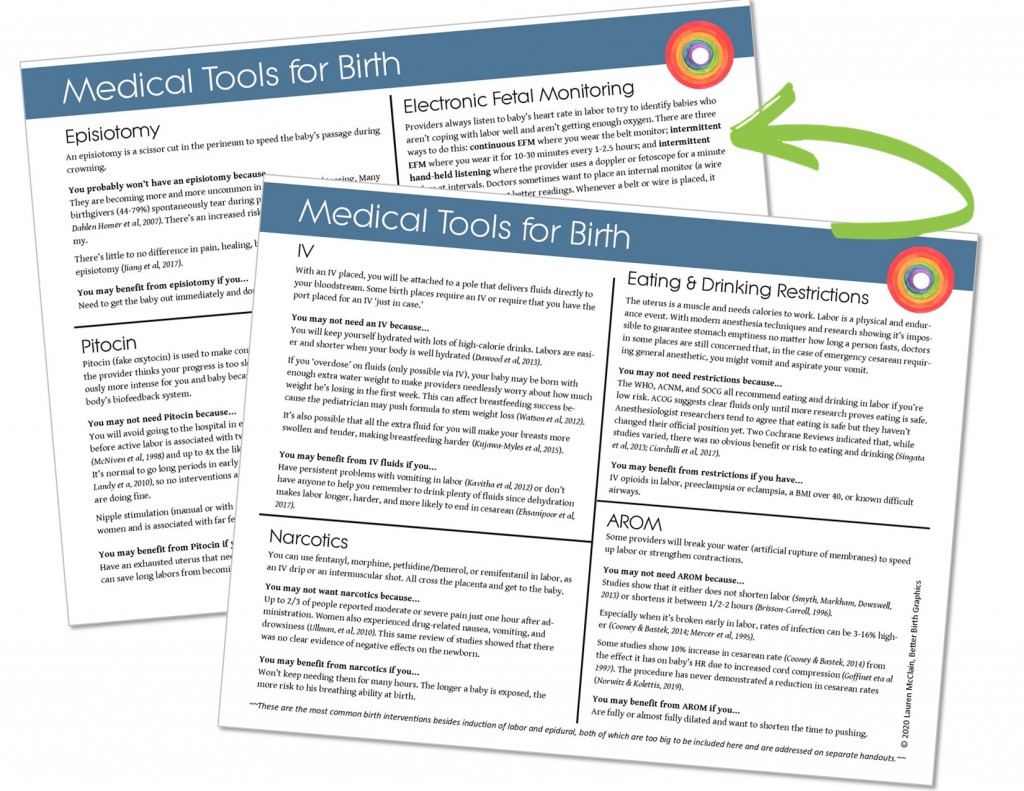Medical Tools/Birth Interventions Research Handout
Here is the research on the most common medical tools used in birth. A practical, quick-reference that gives you an understanding of interventions at-a-glance.
A full text of the double-sided resource is included below.
Pros & Cons of IV
With an IV placed, you will be attached to a pole that delivers fluids directly to your bloodstream. Some birth places require an IV or require that you have the port placed for an IV ‘just in case.’
You may not need an IV because…
You will keep yourself hydrated with lots of high-calorie drinks. Labors are easi-er and shorter when your body is well hydrated (Dawood et al, 2013).
If you ‘overdose’ on fluids (only possible via IV), your baby may be born with enough extra water weight to make providers needlessly worry about how much weight he’s losing in the first week. This can affect breastfeeding success be-cause the pediatrician may push formula to stem weight loss (Watson et al, 2012).
It’s also possible that all the extra fluid for you will make your breasts more swollen and tender, making breastfeeding harder (Kujawa-Myles et al, 2015).
You may benefit from IV fluids if you…
Have persistent problems with vomiting in labor (Kavitha et al, 2012) or don’t have anyone to help you remember to drink plenty of fluids since dehydration makes labor longer, harder, and more likely to end in cesarean (Ehsanipoor et al, 2017).
Pros & Cons of Narcotics
You can use fentanyl, morphine, pethidine/Demerol, or remifentanil in labor, as an IV drip or an intermuscular shot. All cross the placenta and get to the baby.
You may not want narcotics because…
Up to 2/3 of people reported moderate or severe pain just one hour after ad-ministration. Women also experienced drug-related nausea, vomiting, and drowsiness (Ullman, et al, 2010). This same review of studies showed that there was no clear evidence of negative effects on the newborn.
You may benefit from narcotics if you…
Won’t keep needing them for many hours. The longer a baby is exposed, the more risk to his breathing ability at birth.
Pros & Cons of Eating + Drinking
The uterus is a muscle and needs calories to work. Labor is a physical and endurance event. With modern anesthesia techniques and research showing it’s impossible to guarantee stomach emptiness no matter how long a person fasts, doctors in some places are still concerned that, in the case of emergency cesarean requiring general anesthetic, you might vomit and aspirate your vomit.
You may not need restrictions because…
The WHO, ACNM, and SOCG all recommend eating and drinking in labor if you’re low risk. ACOG suggests clear fluids only until more research proves eating is safe. Anesthesiologist researchers tend to agree that eating is safe but they haven’t changed their official position yet. Two Cochrane Reviews indicated that, while studies varied, there was no obvious benefit or risk to eating and drinking (Singata et al, 2013; Ciardulli et al, 2017).
You may benefit from restrictions if you have…
IV opioids in labor, preeclampsia or eclampsia, a BMI over 40, or known difficult airways.
Pros & Cons of Breaking Water
Some providers will break your water (artificial rupture of membranes) to speed up labor or strengthen contractions.
You may not need AROM because…
Studies show that it either does not shorten labor (Smyth, Markham, Dowswell, 2013) or shortens it between 1/2-2 hours (Brisson-Carroll, 1996).
Especially when it’s broken early in labor, rates of infection can be 3-16% high-er (Cooney & Bastek, 2014; Mercer et al, 1995).
Some studies show 10% increase in cesarean rate (Cooney & Bastek, 2014) from the effect it has on baby’s HR due to increased cord compression (Goffinet eta al 1997). The procedure has never demonstrated a reduction in cesarean rates (Norwitz & Kolettis, 2019).
You may benefit from AROM if you…
Are fully or almost fully dilated and want to shorten the time to pushing.
Pros & Cons of Episiotomy
An episiotomy is a scissor cut in the perineum to speed the baby’s passage during crowning.
You probably won’t have an episiotomy because…
They are becoming more and more uncommon in favor of natural tearing. Many birthgivers (44-79%) spontaneously tear during pushing (Soong and Barnes, 2005; Dahlen Homer et al, 2007). There’s an increased risk of severe tearing with episiotomy.
There’s little to no difference in pain, healing, blood loss, or APGAR scores with episiotomy (Jiang et al, 2017).
You may benefit from episiotomy if you…
Need to get the baby out immediately and don’t have the energy to push.
Pros & Cons of Pitocin
Pitocin (fake oxytocin) is used to make contractions stronger and longer when the provider thinks your progress is too slow. Pitocin contractions are notoriously more intense for you and baby because they’re not regulated by your own body’s biofeedback system.
You may not need Pitocin because…
You will avoid going to the hospital in early labor. Admittance to the hospital before active labor is associated with twice the incidence of Pitocin augmentation (McNiven et al, 1998) and up to 4x the likelihood of cesarean (Mikolajczyk et al, 2016). It’s normal to go long periods in early labor without dilation progress (Zhang, Landy et a, 2010), so no interventions are appropriate before 6 cm if you and baby are doing fine.
Nipple stimulation (manual or with a breastpump) works as well for about half of women and is associated with far fewer cesareans (Stein et al, 1990).
You may benefit from Pitocin if you…
Have an exhausted uterus that needs help contracting. Responsibly used Pitocin can save long labors from becoming cesareans.
Pros & Cons of Electronic Fetal Monitoring
Providers always listen to baby’s heart rate in labor to try to identify babies who aren’t coping with labor well and aren’t getting enough oxygen. There are three ways to do this: continuous EFM where you wear the belt monitor; intermittent EFM where you wear it for 10-30 minutes every 1-2.5 hours; and intermittent hand-held listening where the provider uses a doppler or fetoscope for a minute or less at intervals. Doctors sometimes want to place an internal monitor (a wire in the baby’s scalp) to get better readings. Whenever a belt or wire is placed, it restricts your movement.
You will probably want to avoid continuous EFM because…
Since hospitals started using continuous EFM, the cesarean rate has skyrocket-ed and there has been no decrease in negative outcomes for babies or their mothers. We’re doing more cesareans without preventing any problems.
“Non-reassuring fetal heart tones” is the second most common reason for a cesarean in the U.S. Many, many studies show that using continuous EFM results in more cesareans—up to 63% more. It also leads to 15% more instrumental births. It doesn’t matter if you’re low risk, high risk, or preterm—there is an increase in cesarean rate among continuous EFM users and no difference in cerebral palsy, infant mortality or other incidence of problems with newborns. (Alfirevic, etl al, 2017).
False positive rates for predicting problems are as high as 99.8%, even when there are multiple danger signs (Nelson et al, 1996).
You may benefit from continuous EFM if you…
Are having your baby at a hospital where they don’t have the staff or the equipment to do intermittent hand-held listening.





